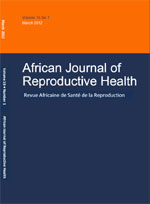
|
African Journal of Reproductive Health
Women's Health and Action Research Centre
ISSN: 1118-4841
Vol. 6, No. 2, 2002, pp. 39-50
|
 Bioline Code: rh02020
Bioline Code: rh02020
Full paper language: English
Document type: Research Article
Document available free of charge
|
|
|
African Journal of Reproductive Health, Vol. 6, No. 2, 2002, pp. 39-50
| fr |
OA Dada, FA Akesode, DM Olanrewaju, OA Olowu, O Sule-Odu, TA Fakoya, FA Oluwole, BV Odunlami and WHO Task Force on Methods for the Natural Regulation of Fertility
Résumé
L'allaitement et l'aménorrhée qui se rapporte à la lactation à Sagamu, au Nigéria. Cinq cent vingt femmes instruites et allaitant à Sagamu ont été observées prospectivement afin de décrire leurs pratiques d'allaitement et pour déterminer s'il était possible d'identifier quelques indices du retour des règles. Les femmes sont restées aménorrhéiques pendant sept mois. Comparées aux femmes qui ont été selectionnées de la même manière dans d'autres pays, elles nourrissaient régulierement leurs enfants du supplément dès leur très jeune âge; pourtant la fréquence de l'allaitement et la durée n'ont pas baissé de façon dramatique. A l'âge de presque quatre mois, on a initié les enfants à la nourriture semi-solides. Une telle administration d'un supplément aussi bien qu'une administration antérieure d'un supplément du lait et d'autres nourritures à base du lait, ont été associées au retour des règles. La durée médiane de l'abstinence était à peu près quatre mois, mais la moyenne a probablement duré plus longtemps. Aucune femme n'est devenue enceinte qu'après avoir sevré l'enfant. (Rev Afr Santé Reprod 2002; 6[2]: 39-50)
|
| |
| en |
Infant Feeding and Lactational Amenorrhea in Sagamu, Nigeria
OA Dada, FA Akesode, DM Olanrewaju, OA Olowu, O Sule-Odu, TA Fakoya, FA Oluwole, BV Odunlami and WHO Task Force on Methods for the Natural Regulation of Fertility
Abstract
Five hundred and twenty educated, breastfeeding women in Sagamu, Nigeria, were observed prospectively in order to describe their infant feeding practices and to determine whether any predictors of the return of menses could be identified. The women remained amenorrheic for seven months. Compared with similarly selected women in other countries, they regularly fed their infants with supplements from a very early age, yet breastfeeding frequency and duration did not decline dramatically. Semi-solid food was introduced at about four months and such supplementation, as well as earlier supplementation with milk/milk-based feedings, was associated with the return of menses. The median duration of abstinence was about four months but the mean may have been much longer. No woman became pregnant until her infant was weaned. (Afr J Reprod Health 2002; 6[2]: 39-50)
Keywords
Breastfeeding, fertility, Nigeria, infant, amenorrhea Africa
|
| |
© Copyright 2002 - Women's Health and Action Research Centre
Alternative site location: http://www.ajrh.info
|
|
